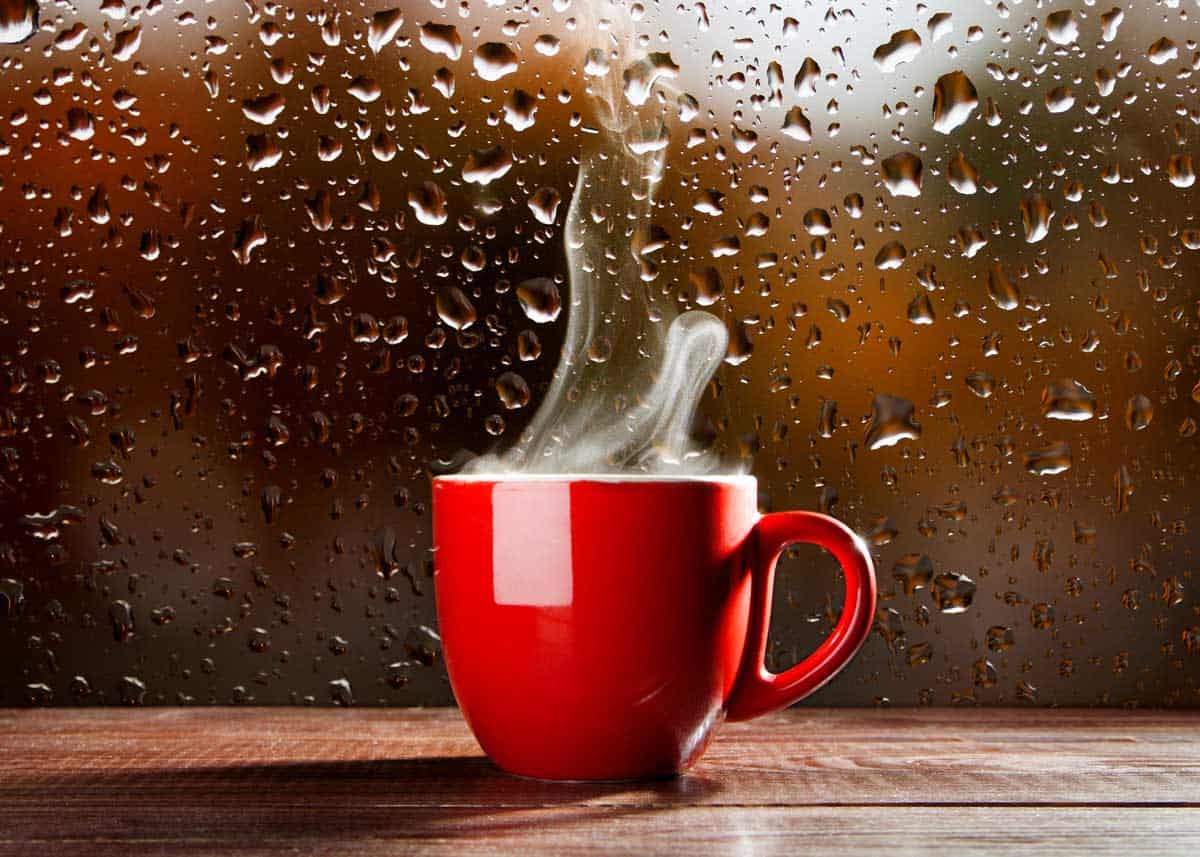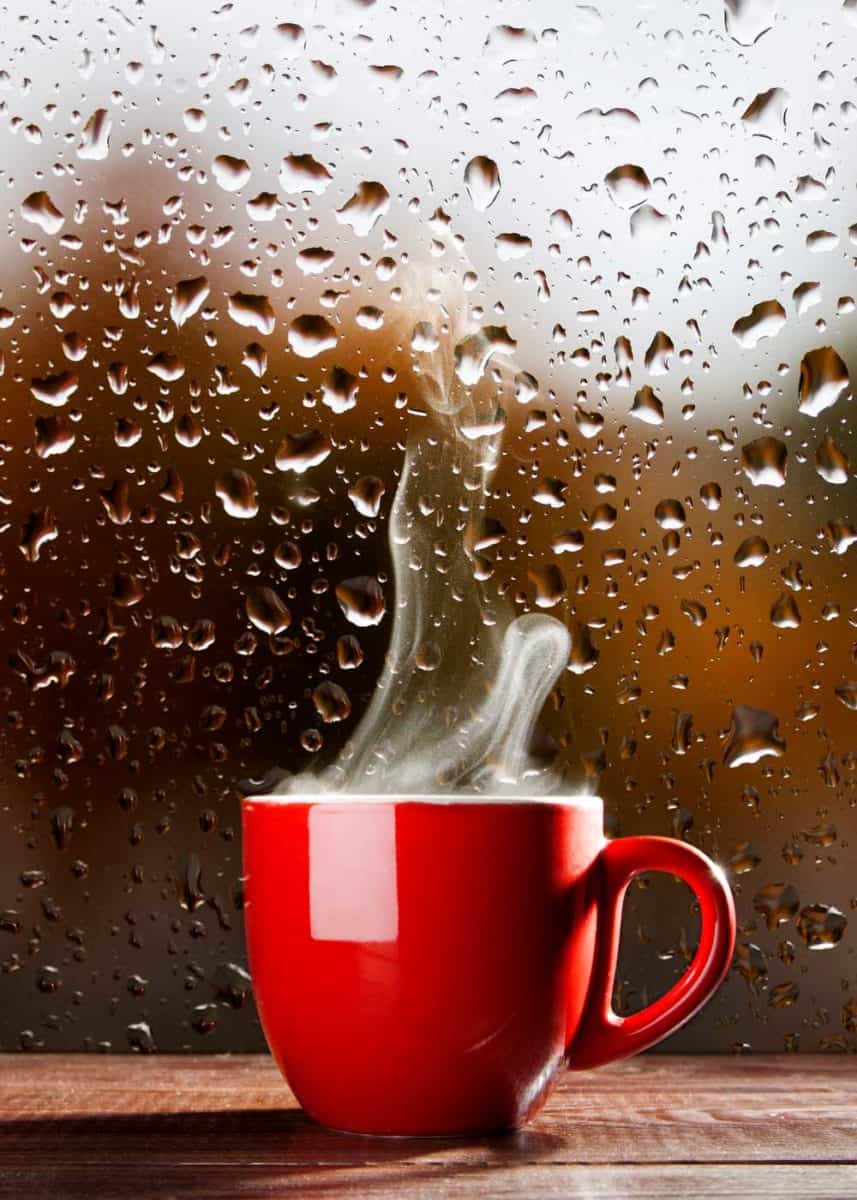Which has more caffeine, coffee or tea? And what factors affect caffeine levels?
Comparing tea vs coffee caffeine levels is easy. A standard coffee (95 mg) has double the caffeine compared to a black tea (47 mg). But coffee beans have less caffeine that tea leaves, before brewing. And a single espresso has similar caffeine to a black tea.

In this guide, you’ll learn the caffeine levels for 13 types of coffee and tea. But there are 9 variables to consider. Some tea has higher caffeine levels than some coffee.
Table of Contents
Tea vs Coffee Caffeine
Caffeine is the reason many people drink coffee and tea.
Caffeine is a naturally occurring pesticide. Its chemical name is 1,3,7 trimethylxanthine. and it is found in coffee beans, tea leaves, guarana seeds, and cocoa beans.
Is there more caffeine in tea or coffee?
- Coffee: 95 mg of caffeine (8 ounces of brewed coffee)
- Black Tea: 47 mg of caffeine (1 cup of steeped tea)
Coffee has more caffeine than tea, using traditional brew methods and typical volumes.
Tea Leaves are Higher in Caffeine Than Coffee Beans
By weight, tea leaves contain more caffeine than coffee beans. Before brewing, tea leaves contain 1.5 to 3 times more caffeine than coffee beans.
Here is the amount of caffeine in each of these agricultural products:
- Guarana (Paullinia cupana) 4–7%
- Tea leaves (Camellia sinensis) 3.5%
- Maté tea leaves (Ilex paraguariensis) 0.89–1.73%
- Coffee beans (Coffea spp.) 1.1–2.2%
- Cola nuts (Cola vera) 1.5%
- Cocoa beans (Theobroma cacao) 0.03%
Source: Czech Journal of Food Sciences (Determination of Caffeine Content in Tea and Maté Tea by Using Different Methods). Citing Clifford et al. 1990.
Brewed Coffee Has More Caffeine Than Steeped Tea
But this high caffeine level of tea leaves doesn’t translate to the prepared beverage for a few reasons.
- Tea isn’t brewed as strong as coffee. Because tea is noticeably weaker than even weak coffee, it contains less caffeine. Steeped tea is almost always clear, allowing full light through. Brewed coffee is almost always opaque, not allowing any light to pass.
- Coffee is brewed with hotter water. The hotter water of coffee brewing extracts more caffeine.
Caffeine Compared: Tea vs Coffee (13 Drinks)
To help make sense of the data, here are 6 types of coffee compared against 7 varieties of tea.
Caffeine in 6 Types of Coffee
Here are the variable levels of caffeine in these different types of coffee.
- Brewed Coffee: 95 mg of caffeine (8 ounces / 237 ml)
- Brewed Coffee (Decaf): 2 mg of caffeine (8 ounces / 237 ml)
- Espresso: 64 mg of caffeine (1 ounce / 30 ml)
- Espresso (Decaf): 0 mg of caffeine (1 ounce / 30 ml)
- Instant Coffee: 62 mg of caffeine (8 ounces / 237 ml)
- Instant Coffee (Decaf): 2 mg of caffeine (8 ounces / 237 ml)
Source: Mayo Clinic
There are a couple of details worth noting here.
- Most people don’t drink just 8 ounces of coffee. Standard coffee shop cup sizes are generally larger than 8 ounces. A large (or venti) can score you between 20 and 24 oz of coffee. This is 2.5X and 3X more than the above metric. This means you could be getting almost 300 mg of coffee in one drink.
- Most people drink double espressos. The above metric is for a single espresso shot. And it has less caffeine than a standard cup of coffee. But take a double espresso and it has 27% more caffeine than brewed coffee.
Here’s more about the difference between espresso and brewed coffee.
Did you notice? A single espresso shot (64 mg) has a similar amount of caffeine to a steeped tea (47 mg).
These tea vs coffee caffeine charts can help to sort out the differences between these drinks.
Caffeine in 7 Tea Varieties
Here are the variable levels of caffeine in these different types of coffee.
- Brewed Black Tea: 47 mg of caffeine (8 ounces / 237 ml)
- Brewed Black Tea (Decaf): 2 mg of caffeine (8 ounces / 237 ml)
- Brewed Green Tea: 28 mg of caffeine (8 ounces / 237 ml)
- Bottled, ready-to-drink tea: 19 mg of caffeine (8 ounces / 237 ml)
- Nestea Original Lemon Iced Tea: 10 mg of caffeine (8.4 oz / 250 ml)
- Nestea Sweet Iced Tea: 26.5 mg of caffeine (serving)
- Herbal Tea contains no caffeine
Source: Mayo Clinic, Made With Nestle, University of Utah, Harvard University
Does black tea have more caffeine than coffee? Not in traditional brew methods. Black tea has 47 mg of caffeine compared to 95 mg in an 8 oz cup of coffee.
Does Earl Grey tea have more caffeine than coffee? No, Earl Grey is a type of black tea. And it has about half the caffeine of a cup of brewed coffee.
What is the caffeine in English breakfast tea vs coffee? As a blend of black teas, English breakfast tea has less caffeine than coffee. Coffee has about twice the caffeine of a cup of an English breakfast tea blend.
Which has more caffeine, coffee or green tea? While green tea still has some caffeine (just 28 mg) it has much less than a cup of coffee. An 8-ounce cup of coffee has almost 4 times the caffeine (95 mg) compared to a cup of green tea.
9 Variables Affecting Caffeine Levels
In addition to the variable already considered, there are other factors affecting caffeine levels in your hot drink.
6 Coffee Variables Affecting Caffeine
- Coffee Roast: There are five types of coffee roasts. The type of roast can increase or decrease caffeine levels in your coffee.
- Coffee Grind: The finer the grind, the more flavor (and caffeine) will be in your coffee.
- Coffee Beans: Arabica, robusta, liberica, or excelsa beans
- Coffee Brew Method: Some brew methods make a weaker coffee. And others make a very strong brew.
- Decaf: This is obvious, but a cup of decaf will have a tiny fraction of the caffeine of your regular coffee.
- Coffee Volume: Cup size will directly affect how much caffeine is in your coffee.
3 Tea Variables Affecting Caffeine
- Tea Variety: Green tea has roughly half the caffeine as black tea.
- Brew time: The longer your leaves steep, the more caffeine will be in your cup. Steep it too long, and it might become undrinkable.
- Tea Volume: The measurements in this article are based on a tea cup portion. If you fill a large travel mug with tea, you’ll consume much more caffeine per “cup.”

Your Turn
The Mayo Clinic recommends keeping your daily caffeine intake at a maximum of 400 mg. Of course, this can vary by individual. Keep these caffeine levels in mind as you enjoy trying the many types of coffee.
- About the Author
- Latest Posts
Bryan Haines is a co-founder and writer on EnjoyJava – and is working to make it the best coffee blog in the world.
He is a travel blogger at Storyteller Travel and blogs about photography at Storyteller Tech. He is also co-founder of Storyteller Media, a company he started with his wife, Dena.
